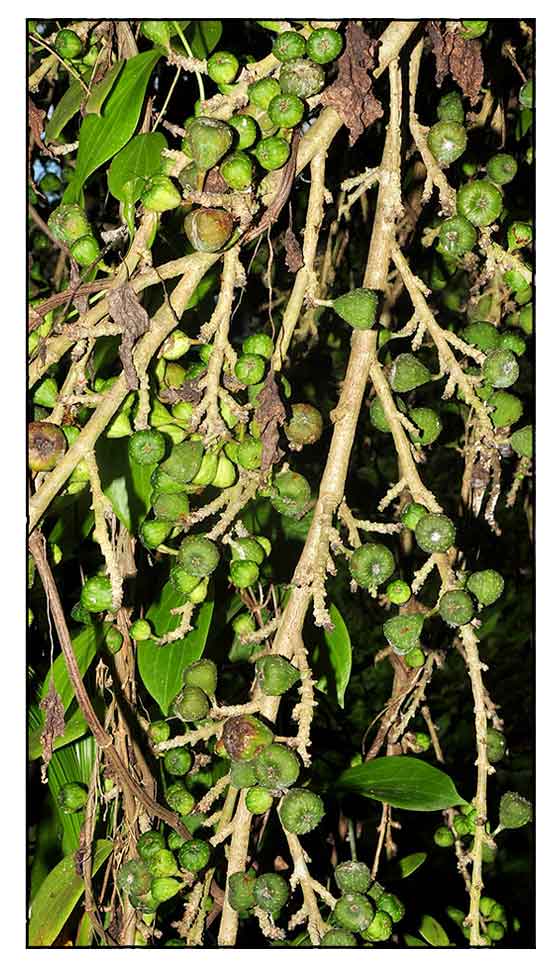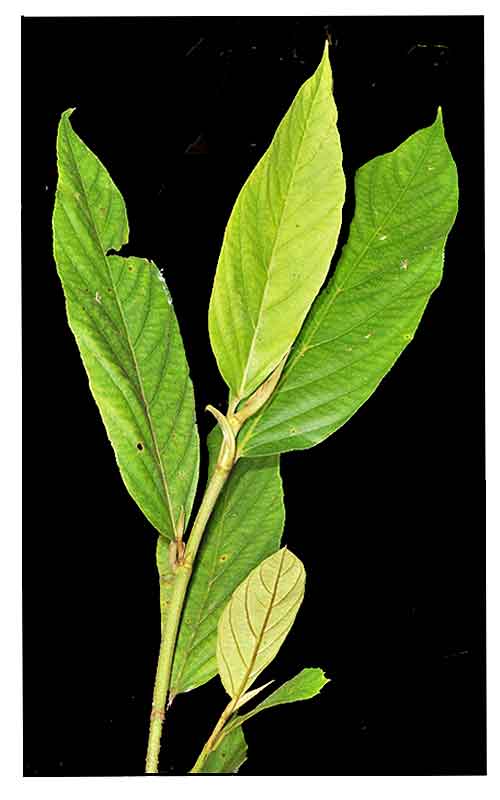 Gen info Gen info
- Ficus is a genus of about 850 species of woody trees, shrubs, vines, epiphytes and hemiepiphytes in the family Moraceae.
- The species epithet botryocarpa derives from Latin, meaning producing offsets, bearing progeny as offshoots. (Stearn 1973)
Botany
Ficus botryocarpa is a small tree up to 14 m tall. Leaves distichous or opposite, elliptical, 9-26 cm × 3-11 cm, base cuneate, apex shortly acuminate, margin entire, with 6-10 pairs of lateral veins, glabrous or sparsely hairy below, pale red when young, stipules 1-2.5 cm long. Figs cauliflorous, paired, subglobose, 15-27 mm in diameter, glabrescent, spotted green ripening yellowish-white; male flowers with 1 stamen, female flowers sessile or shortly stipitate. (1)
Distribution
- Native to the Philippines.
- Also native to Bismarck Archipelago, Maluku, New Guinea, Sulawesi.
- In primary forest and secondary lowland to montane forests, often along rivers, up to 1700 m altitude.
Constituents
- Study of stem bark isolated three pentacyclic triterpenoids: lupeol acetate, ß-amyrin acetate and α-amyrin acetate. The fruit latex showed presence of ficuseptine. (see study below) (3)
Properties
- Studies have suggested antimicrobial, cytotoxic, anticancer, wound healing properties.
Parts used
Fruit latex, stem bark, sap.
 Uses Uses
Edibility
- Fruit is edible.
-
Young leaves and figs eaten raw or boiled as a vegetable with rice.
Folkloric
- In Agusan del Sur, Philippines, the Manobo tribe of Prosperida rub, squeeze, and drink the sap from young stems to treat body and muscle pain. (8) Manobo and Higaonon indigenous communities of Esperanza use roots for fever, headache, diabetes, post-partum care. (9)
- Subanen tribe of Lapuyan, Zamboanga del Sur, use
trunk parts as ingredient in a polyherbal decoction mixture for treatment of cancer. (10)
-
In Papua New Guinea, fruit latex applied to boil to facilitate healing. Also used for treatment of sores, wounds, and other superficial skin infections.
Studies
• Antimicrobial / Fruit Latex and Stem Bark: Study evaluated the chemicals responsible for the antimicrobial activity of fruit latex and stem bark of F. botryocarpa. Three alkaloid fractions showed high antimicrobial activity against Escherichia coli, Staphylococcus aureus and two bacterial colonies isolated from an actual skin infection. From the stem bark, three pentacyclic triterpenoids were isolated: lupeol acetate, which showed activity against S. aureus and K. pneumonia, and ß-amyrin acetate and α-amyrin acetate, which showed activity against both gram positive and gram negative bacteria: B. cereus, S. aureus, E. coli, and K. pneumonia. (see constituents above) (3)
 • Antimicrobial / Fruit Latex: Study of methanol extract of fruit latex showed good antibacterial activity against 25 indicator bacteriae. Alkaloidal fractions isolated showed good antimicrobial activity against Staphylococcus aureus, Escherichia coli and bacterial specimen (SYX and LWC) isolated from infectious folliculitis. (4) • Antimicrobial / Fruit Latex: Study of methanol extract of fruit latex showed good antibacterial activity against 25 indicator bacteriae. Alkaloidal fractions isolated showed good antimicrobial activity against Staphylococcus aureus, Escherichia coli and bacterial specimen (SYX and LWC) isolated from infectious folliculitis. (4)
• Cytotoxicity / Inhibition of Human Liver Cancer Cell Line / Fruit Latex: Study evaluated the cytotoxic activity of extracts of Ficus botryocarpa and Triphala in human liver cancer HepG2 cell line by MTT assay. Ficus botryocarpa exhibited significant cytotoxicity against HepG2 cell line and normal cell lines (Vero cells) with IC50s ranging from 132.46 (?) and 258.23 µg/mL, respectively. Results suggest potential in the search for an anti-liver cancer drug. (5)
• Wound Healing / Mixture with Slaked Lime / Sap: In Papua New Guinea, F. botryocarpa is used in combination with locally prepared slaked lime for use in dermatological infections. Study evaluated use of the sap of F. botryocarpa for treatment of tropical ulcers. Effects on dermal fibroblast viability with and without slaked lime are examined. The sap of F. botryocarpa contains the alkaloid ficuseptine and a single major component and displays antibacterial activity. The addition of slaked lime did not greatly increase the cytotoxicity of the plant material towards dermal fibroblasts. The sap presents as a highly accessible alternative to conventional antiseptics for use in remote communities. (6)
• Phenantroindolizidine Alkaloids / Ficuseptine / Fruit Latex: The latex of F. botryocarpa is applied on skin infections in Papua New Guinea ethnotherapeutic practices. Bioassay guided separation of latex resulted in three bioactive fractions. The fractions showed strong activity against Escherichia coli, S. aureus, and two bacterial colonies from infected folliculitis. Isolates 1, 2, and 3 were identified as ficuseptine. The ficuseptine derivatives were extremely polar and cationic. The latex is not active in wet weather, which may indicate stable ficuseptine is of bioactive significance vice versa. There appears to be an association between gummy precipitate (F1) and milky latex (FL) synonymous of the ficuseptine behaving as an emulsifying agent. (7)
Availability
Wild-crafted.
|

![]()






